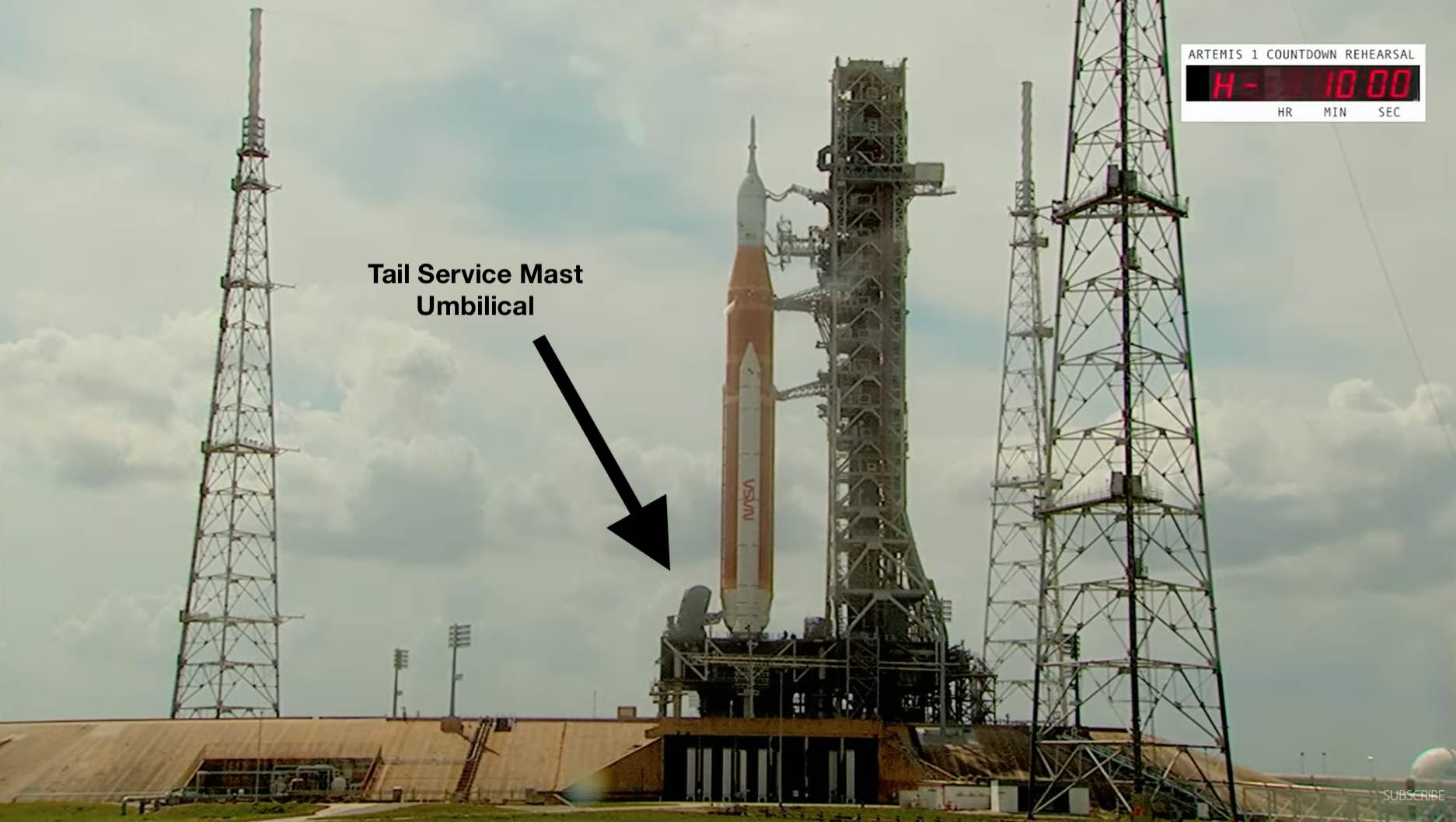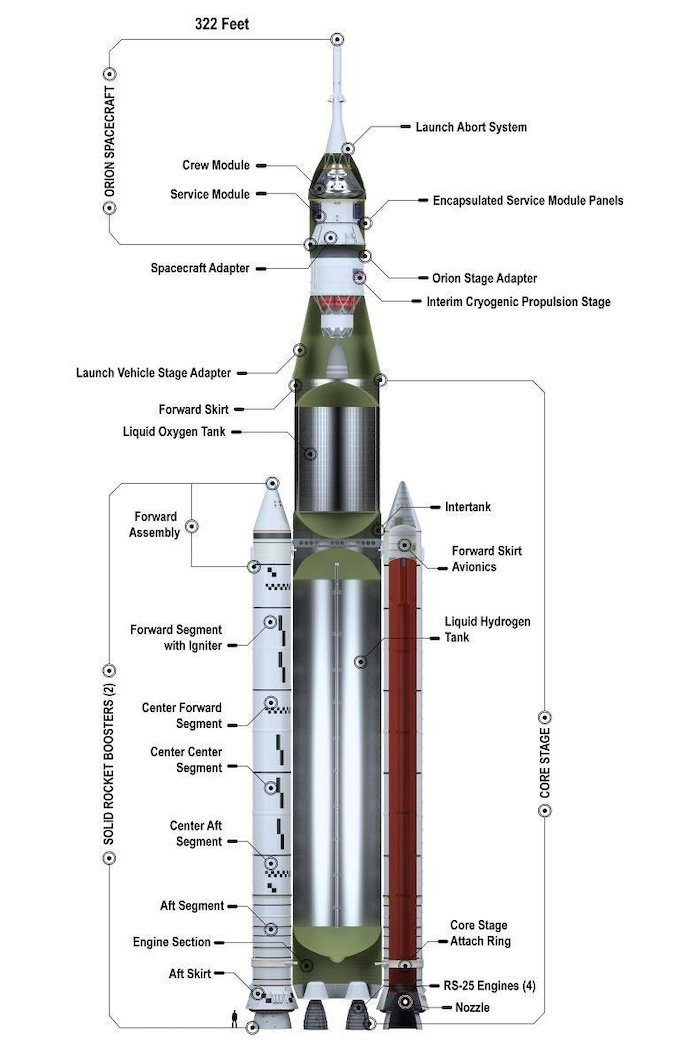
Confident that out-of-bounds engine temperature readings during Monday’s Artemis 1 countdown came from a bad sensor, NASA officials gave the green light Thursday to move forward with another try Saturday afternoon to launch the agency’s giant new moon rocket on an unpiloted test flight from the Kennedy Space Center.
NASA engineers have also adjusted the timeline for loading super-cold propellants into the Space Launch System moon rocket, allowing more time to flow cryogenic liquid hydrogen through bleed lines to thermally condition the four main engines on the bottom of the core stage.
Several days of analyses and the revised countdown timeline gave NASA managers enough confidence to develop “flight rationale” to proceed into another countdown Saturday.
Liftoff of the SLS moon rocket is scheduled during a two-hour window opening at 2:17 p.m. EDT (1817 GMT) Saturday. The 322-foot-tall (98-meter) rocket — making its first-ever flight — is the most powerful ever built by NASA, and will produce 8.8 million pounds of ground-shaking thrust at liftoff, more than any launch vehicle ever flown from U.S. soil.
The Space Launch System rocket will send NASA’s human-rated Orion spacecraft on an unpiloted voyage to orbit the moon and return to Earth. If the launch gets off the ground Saturday, the Orion spacecraft will splash down in the Pacific Ocean west of San Diego on Oct. 11.
The mission is known as Artemis 1, and will pave the way future crew flights around the moon on the SLS moon rocket and Orion capsule, beginning with Artemis 2 set for launch in 2024.
NASA officials met Thursday to review the plan for Saturday’s launch attempt. Officials agreed to accept a “marginal increase” in risk going into the countdown this weekend, said Mike Sarafin, NASA’s Artemis 1 mission manager.
The risks stem from the thermal conditioning of the rocket’s four main engines, which was the primary cause for scrubbing Monday morning’s countdown. The launch team also detected, and and then resolved, a hydrogen leak in a tail service mast umbilical near the connection between the rocket and its mobile launch platform. Since Monday, technicians at Launch Complex 39B have re-torqued a line believed to be the culprit for the leak.

There was also an intermittent leak discovered in a vent valve system near the “intertank” section during Monday’s countdown, but the system sealed up on its own when exposed to cryogenic temperatures, which can cause seals to contract and re-seat themselves.
Teams also found a crack in part of the foam insulation on the core stage. The crack itself not a problem for the rocket, but managers evaluated the “very low” chance that a piece of foam could break during launch,” Sarafin said. If it did, there’s a small chance it could hit and damage a motor that will help one of the solid rocket boosters cleanly separate from the core stage about two minutes into the flight.
“We reviewed our risk acceptance rationale and our overall risk posture ,and we are setting up for a launch attempt on Sept. 3, Saturday,” Sarafin said. “We’re comfortable with our flight rationale and risk acceptance there.”
Forecasters predict a 60% chance of favorable weather during Saturday’s launch window. The probability for a backup launch opportunity Monday, Sept. 5, is slightly better, with a 70% chance of acceptable weather for launch. There’s also a launch opportunity available Tuesday, Sept. 6, but NASA can only use it if the launch team does not proceed into tanking of the Artemis 1 moon rocket Monday.
Ultimately, the launch team called off Monday’s attempt when a sensor reading on one of the four hydrogen-fueled core stage engines — Engine No. 3 — showed it was not reaching the expected cryogenic temperature during a pre-launch “chilldown” procedure.
Engineers want the RS-25 engines to be chilled to around minus 420 degrees Fahrenheit — about the same temperature as liquid hydrogen — to be at the proper temperature for the engine startup sequence. The temperature of Engine No. 3 on Monday was around minus 380 degrees, according to sensor data, giving engineers concern that not enough super-cold liquid hydrogen was was reaching the engine through a chilldown bleed line.

John Honeycutt, NASA’s program manager for the huge SLS moon rocket, said Thursday engineers are now confident the temperature reading during Monday’s countdown was erroneous, and the engines were at the correct temperature.
“We have convinced ourselves, without a shadow of a doubt, that we have good quality liquid hydrogen going through the engines,” Honeycutt said. “There’s no fuzz on that.”
Honeycutt said engineers will look at five additional measurements on the engines during Saturday’s countdown to assure themselves that the engines are at the right temperature, specifically moving parts like fast-spinning turbines and pumps. There’s also data from the core stage itself indicating it was supplying the right amount of liquid hydrogen to the engines to chill them for ignition.
“We chill engines for numerous reasons, but the primary one is for the high pressure turbopump bearing,” said John Blevins, NASA’s chief engineer on the SLS moon rocket. “That high pressure turbopump bearing doesn’t have to be all the way as cold as the liquid, but it’s got to be cold. And if we know the liquid is going through, then we know it’s about that temperature.”
“We know we had a bad sensor,” Honeycutt said. “That was our challenge early in the week, where we could not make the physics of the system line up with what we were seeing with that one sensor.”
The engine bleed system was not fully tested during a series of countdown rehearsals on the SLS moon rocket earlier this year. A connector associated with the bleed line leaked during a countdown test in June, and the launch team bypassed the bleed system during that rehearsal.
Blevins said the launch team gains confidence about the temperature of the engines if they know the hydrogen fuel reaches the engines as a liquid, and doesn’t boil off in the bleed system. If the cold liquid flows through the bleed lines for a certain of time, engineers will know the RS-25 core stage engines are at the right temperature.
The Artemis 1 launch team will begin conditioning ground transfer lines for propellant loading around 6 a.m. EDT (1000 GMT) Saturday, then start flowing propellants into the rocket’s core stage about an hour later. More than 750,000 gallons of liquid hydrogen and liquid oxygen will be loaded into the SLS core stage and upper stage.
The “kickstart” bleed for the main engines will begin around 8 a.m. EDT (1200 GMT), earlier in the countdown timeline than before. The change will give more time for engine temperatures to reach the proper parameters for ignition.

The suspect temperature sensor blamed for Monday’s scrub is designed to collect engineering data to show that the engines are cooling down during the countdown. The engines also have separate “operational flight instrumentation” to feed data to their advanced health monitoring systems, which provide a self-check on the engine status just before ignition and in flight.
The rocket’s on-board computer takes control of the countdown at T-minus 30 seconds, and is designed to halt the countdown if the engines are not within the proper temperature and pressure parameters — called the “start box” — before ignition. The four RS-25 engines on the core stage, all leftovers from the space shuttle program, will fire up in a staggered sequence at T-minus 6 seconds.
When the countdown clock hits zero, assuming the RS-25 engines pass their automated health check, the SLS flight computer will issue the command to ignite the rocket’s two side-mounted solid-fueled boosters, providing more than 80% of the thrust for the first two minutes of the flight.
Each main engine’s health monitoring system is designed to detect excessive vibrations in the event of a bad startup, allowing the engine to safely shut down before causing a catastrophic “uncontained failure,” officials said.
Blevins said the engine turbopump can “skid” if it lights without being properly chilled.
“Ultimately, that causes excess wear on startup,” Blevins said. “That would manifest potentially as a shutdown during flight. It would be a redline. It wouldn’t be an uncontained failure, generally, for that particular issue.
“We have advanced health monitoring on the engines for a reason,” Blevins said. “These are … really the highest horsepower per mass devices that’ve ever been built. So we need that health monitoring. There are numerous things that we’re looking for.”
The RS-25 engines each produce more than 400,000 pounds of thrust at sea level, and will fire for eight minutes to propel the SLS core stage, the upper stage, and the Orion spacecraft to more than 18,000 mph.
Together, the core stage engines will consume 1,500 gallons propellant per second, enough to drain an average 20,000-gallon swimming pool in 13 seconds.
Even with the changes to the countdown and decent weather odds, there’s no guarantee the Artemis 1 mission will get off the ground this Labor Day weekend. That’s a risk with any space mission, but there are 489 launch commit criteria NASA needs to satisfy for the launch team to be “go” for liftoff of the first SLS moon rocket.
“We’ve got a whole host of things that could cause us to not get off on any given day, weather, range or technical, and those are the three big buckets,” Sarafin said. “We talked about 489 launch commit criteria, those are the technical reasons we might not launch that day.
“We might find a combination of technical issues, or somebody being out there on the range that shouldn’t be out there from a public safety standpoint, and just a cloud cell or that kind of stuff could cause us to miss the opportunity,” Sarafin said. “There’s no guarantee that we’re gonna get off on the 3rd, but we’re going to show up and we’re gonna try and we’re going to give it our best.”
Ground teams replenished liquid hydrogen and liquid oxygen supplies at pad 39B since the launch attempt earlier this week to help set up for two more launch attempts before the moon moves out of reach for the SLS moon rocket and the Orion spacecraft. If the rocket doesn’t blast off by Tuesday, the next launch period opens up Sept. 19, when the moon’s position in its orbit again makes the mission possible.
But NASA will have to roll the Artemis 1 moon rocket back to the Vehicle Assembly Building before then for more checks of its flight termination system, which would be used to destroy the rocket if it veered off course after liftoff.
The time needed to return the rocket to the hangar, re-test the flight termination system, then roll the Space Launch System back to 39B and resume launch preps would likely push the Artemis 1 launch into October.
Email the author.
Follow Stephen Clark on Twitter: @StephenClark1.
from Spaceflight Now https://ift.tt/QfJb6yj
via World Space Info







0 comments:
Post a Comment